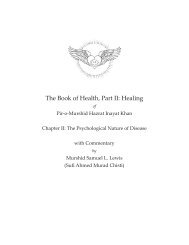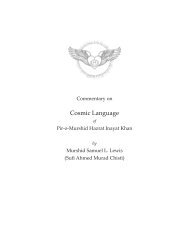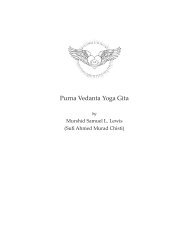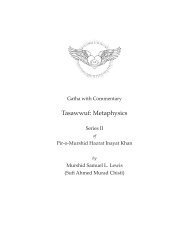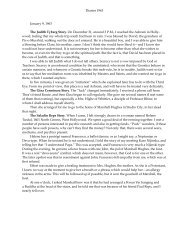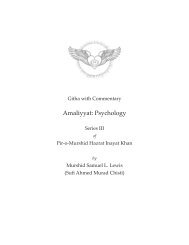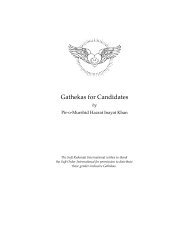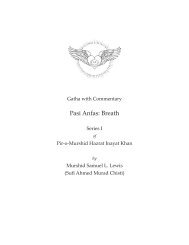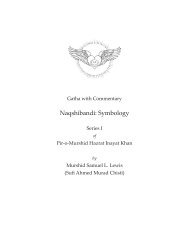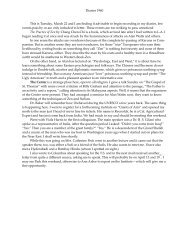Tasawwuf: Metaphysics - Murshid Sam's Living Stream
Tasawwuf: Metaphysics - Murshid Sam's Living Stream
Tasawwuf: Metaphysics - Murshid Sam's Living Stream
You also want an ePaper? Increase the reach of your titles
YUMPU automatically turns print PDFs into web optimized ePapers that Google loves.
<strong>Tasawwuf</strong>: <strong>Metaphysics</strong>—Gatha with Commentary Series I<br />
TASAWWUF: The first is found in the teaching on skandas and samskaras in the Indian teachings.<br />
Even by strengthening the attention on breath this can be done. Also by more heart-concentration.<br />
If one reacts in any way to the efforts of others he adds to the storehouse of samskara, and to argue<br />
on this point increases the samskaric activity even more. The control of one’s own activities comes<br />
through applying the lessons of esoteric practices.<br />
GATHA: Not to resist the activity of another person is an act of patience of the former sort, and to<br />
control oneself when one wishes to do or say a certain thing is an act of patience of the latter sort.<br />
The most difficult test of patience is to have to wait for something which one wants at once.<br />
TASAWWUF: No doubt we find more in Oriental literature about not reacting towards others and in<br />
Western literature about the value of controlling one’s own desire nature, but this is a relative difference.<br />
In the lessons on the Cobra etc., one learns how to look to nature for examples.<br />
The hardest and most valuable aspect of Patience is to work beyond time, to concentrate on a goal<br />
but pay no attention to the time-processes involved. This makes one truly live in Eternity and in<br />
Eternity is all strength, all virtue.<br />
The practice of Meditation is the best means of changing from the temporal life—i.e., life in time to<br />
the everlasting.<br />
GATHA: The symbol of Patience is the cross. The vertical line indicates activity, the horizontal line<br />
control. Patience is, for the saint and the sage, the first lesson and the last.<br />
RYAZAT: Concentration on the cross must therefore be a practice for all disciples, but mostly for<br />
those who are nervous and who find it difficult to wait. And if when one pictures a cross the horizontal<br />
lines are not strong, one should use the balanced, not the traditional Christian cross.<br />
TASAWWUF: In other words, Patience is a sign of selflessness, fana. The greater the advance on fana<br />
the more easily one can assimilate the Divine virtues. But for this an accommodation may be made,<br />
and each time there is accommodation there may be accompanying pain and hardship. It is not that<br />
God is testing us; it is that He is showing that all growth may be accompanied by sorrow.<br />
GATHA: The more one learns to bear, the more one has to bear, such is the nature of life. Yet in reality<br />
patience is never wasted, patience always wins something great, even when to all appearances it<br />
loses.<br />
TASAWWUF: Patience is the movement out of time—from here to eternity, from samskara to what<br />
might be called “nirvana.” It is not true that samskara and nirvana are identical. If so, words lose all<br />
their meaning.<br />
GATHA: Sometimes a patient person seems a vanquished one, but in reality the victory is his. In the<br />
path of mastery, as in the path of renunciation, patience plays the greatest part.<br />
TASAWWUF: In the path of mastery Patience is needed so that one can one exert one’s greatest effort.<br />
We find the same law in physics of the application of force toward movement. It is in this way<br />
that friction and inertia are overcome.<br />
16



